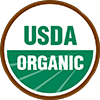Download Free Vegetable Growing Guide PDF
Growing Organic Old German Slicer Tomatoes in the Vegetable Garden
Growing tomatoes from seed is a rewarding process that begins with careful planning and attention to detail. The first step is obtaining high-quality seeds such as those from True Leaf Market! Begin the indoor seeding process about 8 weeks before the last expected frost in your region. Use a well-draining seed-starting mix, and sow the seeds at a depth of about 1/4 inch. Keep the soil consistently moist and provide adequate light, either through natural sunlight or artificial sources like grow lights.
Once the seedlings reach a height of approximately 2 inches and develop true leaves, it's time for their first transplant. Gently transfer each seedling into larger containers filled with nutrient-rich potting soil, fostering healthy root development. Choose containers with drainage holes to prevent waterlogging. Then, after all risk of frost has passed, harden off the seedlings and transplant them outdoors. For those with limited outdoor space or less-than-ideal soil conditions, growing tomatoes in containers is an excellent option. Select large containers, at least 5 gallons in size, to accommodate the plant's root system.
Choosing the perfect growing spot is crucial for optimal tomato health. Tomatoes thrive in full sun, so select a location that receives at least 6-8 hours of direct sunlight daily. Ensure the soil is well-draining and rich in organic matter. Tomatoes prefer slightly acidic to neutral soil with a pH range of 6.0 to 6.8. Consider incorporating compost into the soil to enhance fertility.
For container gardening, place the containers in a sunny spot, such as a patio or balcony, and use a high-quality potting mix. Ensure the containers have drainage holes, and consider adding a layer of mulch to retain moisture and regulate soil temperature.
To promote overall plant health, maintain a consistent watering schedule, keeping the soil evenly moist. Fertilize the plants regularly with a balanced fertilizer, following package instructions. As the seedlings grow, provide support with stakes or cages to prevent sprawling and improve air circulation. Regularly monitor for common tomato pests and diseases, addressing issues promptly with natural remedies or organic pesticides. By following these techniques, you can successfully grow healthy and productive tomato plants from seed, whether in the ground or in containers.
Harvesting Old German Organic Tomatoes
Harvesting organic tomato plants involves careful observation of ripeness indicators. Look for vibrant color, firmness, and a glossy appearance. Gently twist or cut the tomatoes from the plant, leaving a small stem attached. Harvesting regularly encourages continuous fruit production. To maintain organic integrity, avoid synthetic ripening agents. Harvesting at peak ripeness ensures the best flavor and nutrient content, providing a delicious and wholesome addition to your organic produce.
About Organic Old German Tomato Garden Seeds
Old German tomato seeds produce indeterminate vines that continue to grow throughout the season, often reaching up to 10' tall. That's why it's best to stake or use a tomato cage with Old German tomato plants. Staking or caging will help support the vines that hold up the heavy fruit and provide good airflow to keep the Old German tomato plant healthy.
Non-GMO Old German Heirloom Tomato Seeds from True Leaf Market are a staff favorite. The Old German tomato variety is a heritage tomato that hails from the Mennonite community and is beloved for its enormous tomato plants. They are native to the tropical regions of the Americas; frost easily kills tomato plants. Red-yellow fruits with a red center visible on the surface and throughout the core. Old German Tomatoes often weigh over a pound. Outstanding flavor and few seeds.
When fertilizing your plants, particularly tomatoes, opt for a balanced and controlled approach to avoid promoting conditions conducive to diseases. Excessive nitrogen, for example, can lead to lush foliage that may attract diseases like blight. Use a fertilizer with balanced nitrogen, phosphorus, and potassium ratios, and follow recommended application rates.
Heirloom Old German tomatoes are rich in vitamins, minerals, and antioxidants, including vitamins C, A, and K, potassium, and lycopene. For most people, tomatoes are part of a healthy diet.
Before planting tomatoes, conduct a soil test to assess the nutrient levels and pH of the soil. This quick and essential step helps you understand the soil's composition and make informed decisions about fertilization. Adjusting the pH and providing the necessary nutrients based on the soil test results can significantly improve your tomato plants' overall health and productivity. Regular soil testing contributes to successful gardening by creating an optimal growing environment for your tomatoes.
Tips From Our Gardeners
"Growing tomatoes organically involves avoiding synthetic pesticides and fertilizers. To nourish the soil, utilize natural alternatives, such as compost and organic fertilizers. Implement companion planting, crop rotation, and beneficial insects to manage pests. This sustainable approach prioritizes soil health and produces wholesome, chemical-free tomatoes."
 |
- Lara Wadsworth, True Leaf Market Writer
|
Other Resources
Old German Organic Tomato Seeds Per Package:
- 300 mg packet - Approximately 106 Seeds
- .25 oz - Approximately 2,500 Seeds
- 1 oz - Approximately 10,000 Seeds
- 4 oz - Approximately 40,000 Seeds
- 1 lb - Approximately 160,000 Seeds
Non-GMO Old German Tomato seeds are available for Fast Free Shipping on qualifying orders.




















